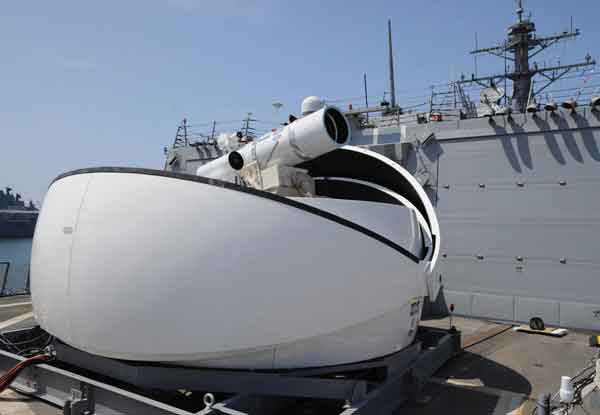当前位置: Language Tips> 双语新闻
'Star Wars' at sea: Navy ready to deploy laser system this summer

|
Some of the Navy's futuristic weapons sound like something out of "Star Wars," with lasers designed to shoot down aerial drones and electric guns that fire projectiles at hypersonic speeds. That future is now. The Navy plans to deploy its first laser on a ship later this year, and it intends to test an electromagnetic rail gun prototype aboard a vessel within two years. For the Navy, it's not so much about the whiz-bang technology as it is about the economics of such armaments. Both costs pennies on the dollar compared with missiles and smart bombs, and the weapons can be fired continuously, unlike missiles and bombs, which eventually run out. "It fundamentally changes the way we fight," said Capt. Mike Ziv, program manager for directed energy and electric weapon systems for the Naval Sea Systems Command. The Navy's laser technology has evolved to the point that a prototype to be deployed aboard the USS Ponce this summer can be operated by a single sailor, he said. The solid-state Laser Weapon System is designed to target what the Navy describes as "asymmetrical threats." Those include aerial drones, speed boats and swarm boats, all potential threats to warships in the Persian Gulf, where the Ponce, a floating staging base, is set to be deployed. Rail guns, which have been tested on land in Virginia, fire a projectile at six or seven times the speed of sound — enough velocity to cause severe damage. The Navy sees them as replacing or supplementing old-school guns, firing lethal projectiles from long distances. But both systems have shortcomings. Lasers tend to loser their effectiveness if it's raining, if it's dusty, or if there's turbulence in the atmosphere, and the rail gun requires vast amount of electricity to launch the projectile, said Loren Thompson, defense analyst at the Lexington Institute. "The Navy says it's found ways to deal with use of lasers in bad weather, but there's little doubt that the range of the weapon would be reduced by clouds, dust or precipitation," he said. Producing enough energy for a rail gun is another problem. The Navy's new destroyer, the Zumwalt, under construction at Bath Iron Works in Maine, is the only ship with enough electric power to run a rail gun. The stealthy ship's gas turbine-powered generators can produce up to 78 megawatts of power. That's enough electricity for a medium-size city — and more than enough for a rail gun. Technology from the three ships in that DDG-1000 series will likely trickle down into future warships, said Capt. James Downey, the program manager. Engineers are also working on a battery system to store enough energy to allow a rail gun to be operated on warships currently in the fleet. Both weapon systems are prized because they serve to "get ahead of the cost curve," Ziv said. In other words, they're cheap. Each interceptor missile aboard a U.S. Navy warship costs at least $1 million apiece, making it cost-prohibitive to defend a ship in some hostile environments in which an enemy is using aircraft, drones, artillery, cruise missiles and artillery, Thompson said. With a laser operating on about 30 kilowatts of electricity — and possibly three times that in the future — the cost amounts to a few dollars per shot, Thompson said. The "Star Wars" analogy isn't a bad one. Just like in the movies, the Navy's laser directs a beam of energy that can burn through a target or fry sensitive electronics. Unlike the movie, the laser beam is invisible to the human eye. The targeting system locks onto the target, sending a beam of searing heat. "You see the effect on what you are targeting but you don't see the actual beam," Ziv said. Other nations are developing their own lasers, but the Navy is more advanced at this point. Most folks are stunned to learn the technology is ready for deployment, Ziv said. "It's fair to say that there are other countries working on this technology. That's safe to say. But I would also say that a lot of what makes this successful came from the way in which we consolidated all of the complexity into something that can be operated by (a single sailor)," he said.
|
据美国媒体2月17日报道,美国海军打算2013年夏天首次在军舰上部署激光炮,并于2年之内对磁轨炮进行初步测试。这些未来范十足的装备颇有电影《星球大战》的风格。 ***电磁武器 美国海军计划夏天在“庞塞”号军舰上部署激光炮。虽然只是原型机,其操作已经非常简单,一名士兵就能胜任。“庞塞”号曾是一艘运输船,近年来被改装成高科技浮动基地,主要在波斯湾区保护军舰,应对无人机、快艇等“不对称威胁”。 美国还在弗吉尼亚州试发过磁轨炮,发射速度相当于6到7倍音速,颇有威力。美国海军打算用它们补充,甚至取代传统大炮。 ***两大局限 美军开发新式武器主要是为了压缩成本,不是追求炫酷的科技。和传统武器相比,电磁武器有两大优势。首先它们价格低廉;其次不必担心弹药储备,能够持续发射。国防专家洛伦•汤普森表示,美国军舰上配备的拦截导弹每一枚耗资至少100万美元(约合606万元人民币),价格昂贵。不过,耗能30千瓦的磁轨炮每发一次只需要几块钱。美国海军海上系统司令部旗下电子武器系统项目主管麦克•齐夫认为,新型电磁武器将从根本上改变人们的作战方式。 电磁武器也有两大局限,它们易受天气影响,并且能耗较高。天气方面,汤普森说:“毫无疑问,云雾、灰尘和降雨会使武器的射程缩短。海军说已经找到了应对方法。”在能量方面,美国只有在建的“朱姆沃尔特”号驱逐舰拥有足够能量满足新型武器。“朱姆沃尔特”号最高能产生78兆瓦电力,相当于一座中型城市的发电水平,发射电磁炮绰绰有余。美军军官表示,以“朱姆沃尔特”号为首的3艘“朱姆沃尔特”级军舰都将配备新式武器。而工程师也正在改进电池系统,方便军舰发射电磁炮。 海军电磁武器不由得让人想起电影《星球大战》中的激光剑,二者都是破坏力十足的一道光。不同的是,我们用肉眼看得到电影里的剑,却看不到军舰上打出的电子“炮弹”。电磁武器瞄准目标发出一道高能光束。齐夫说:“你看得见击中目标的效果,却看不见那一道光。” 相关阅读 (王琦琛 编辑:信莲)
|
上一篇 : 印度法官裁定婚前性行为“反宗教”
下一篇 : 马年说“马”
电话:8610-84883645
传真:8610-84883500
Email: languagetips@chinadaily.com.cn